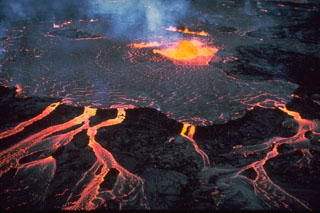Report on Kilauea (United States) — 16 May-22 May 2018
Smithsonian Institution / US Geological Survey
Weekly Volcanic Activity Report, 16 May-22 May 2018
Managing Editor: Sally Sennert.
Please cite this report as:
Global Volcanism Program, 2018. Report on Kilauea (United States) (Sennert, S, ed.). Weekly Volcanic Activity Report, 16 May-22 May 2018. Smithsonian Institution and US Geological Survey.
Kilauea
United States
19.421°N, 155.287°W; summit elev. 1222 m
All times are local (unless otherwise noted)
On 16 May HVO reported ongoing deflation at Kilauea’s summit, where the lava lake continued to recede in the Overlook Crater; by the afternoon the caldera floor had dropped a total of almost 1 m since the onset of the lake drainage. The drop of the floor stressed faults around the caldera causing earthquakes as strong at M 4.4. HVO and National Park staff reported frequent ground shaking, and damage to roads and buildings. Phreatic explosions had ejected blocks up to 60 cm in diameter that were found in the parking lot a few hundred meters from Halema`uma`u Crater. Ash plume heights varied, but generally rose no higher than 1.2 km and drifted N. Lava continued to erupt from multiple vents at the NE end of the active fissure system at the Lower East Rift Zone (LERZ). Lava from fissure 17 advanced about 90 m. Weak spattering arose from fissure 18, and fissure 20 was again active.
At about 0415 on 17 May an explosive event (or a series of explosions) at Overlook Crater generated an ash plume that, according to the Washington VAAC, rose as high as 9.1 km (30,000 ft) a.s.l. and drifted NE. Ash fell in areas downwind, including in the Volcano Golf Course and Volcano Village. Subsequent gas, steam, and ash emissions rose to 3.7 km (12,000 ft) a.s.l. and drifted SW. Fissure 17 actively spattered, though its lava flow had nearly stalled. Fissures 18, 19, and 20 reactivated, and a new fissure (21) opened between fissures 7 and 3. A 50-100-m-wide depression with cracks formed parallel to the fissures between Highway 130 and Lanipuna Gardens, into which pahoehoe lava flowed from fissures 20 and 21. Fissure 22 opened just downrift of fissure 19.
On 18 May a robust gas-and-steam plume rose from Overlook Crater, punctuated by several minor ash emissions. At 2358 a short-lived explosion generated an ash plume that rose up to 3 km (10,000 ft) a.s.l. and drifted SW. Spattering continued from fissures 15, 17, 18, 20, 21, and 22, with pahoehoe lava flows being erupted from fissures 17, 18, and 20. Large fountains at fissure 17 ejected bits of spatter 100 m high. Lava flows from fissure 18 traveled almost 1 km SE, and a flow from fissure 15 crossed Pohoiki Road. A fast-moving lava flow (275-365 m per hour) emerged from fissure 20 and traveled SE, across Pohoiki Road. Gas emissions remained elevated in areas downwind of the fissure system; air quality was poor from gas emissions as well as smoke from burning vegetation. Earthquake locations had not moved farther downrift in the previous few days.
Small ash emissions from Overlook Crater occurred intermittently on 19 May. The eruption of lava and ground cracking in the area of Leilani Estates subdivision continued. Fissure 17 was weakly active after fountaining earlier in the day. Fissures 16-20 merged into a continuous line of spatter and fountaining; flows from this fissure 20 complex flowed 275 m/hour S. Two of the flows joined less than a 1.6 km from the ocean and continued to flow S between Pohoiki and Opihikao roads.
During 19-20 May there were two explosive eruptions from Overlook Crater, and several smaller ash emissions. Lava flows reached the ocean overnight (late on 19 May) along the SE Puna coast. On 20 May spatter was ejected from fissures 6 and 17, and fissure 20 produced significant lava flows. A ground crack opened under the E lava channel diverting lava into underground voids. Gas emissions tripled as a result of the voluminous eruptions from fissure 20. Photos take in the afternoon showed two ocean entries along approximately 1 km of coastline.
A small explosion at Overlook Crater at 0055 on 21 May produced an ash plume that rose around 2.1 km (7,000 ft) a.s.l. and drifted SW. Several smaller emissions throughout the day ejected abundant ash. Robust steam-and-gas plumes also rose from the crater. Lava fountains from fissure 22 fed a channelized lava flow that entered the ocean N of MacKenzie State Park. Spattering occurred at fissures 6, 17, and 19. Small ash emissions from Overlook Crater continued on 22 May. Lava continued to enter the ocean, though by the afternoon only one entry was active. Most of the LERZ activity shifted to the middle part of the fissure system. The Aviation Color Code remained at Red and the Volcano Alert Level remained at Warning.
Geological Summary. Kilauea overlaps the E flank of the massive Mauna Loa shield volcano in the island of Hawaii. Eruptions are prominent in Polynesian legends; written documentation since 1820 records frequent summit and flank lava flow eruptions interspersed with periods of long-term lava lake activity at Halemaumau crater in the summit caldera until 1924. The 3 x 5 km caldera was formed in several stages about 1,500 years ago and during the 18th century; eruptions have also originated from the lengthy East and Southwest rift zones, which extend to the ocean in both directions. About 90% of the surface of the basaltic shield volcano is formed of lava flows less than about 1,100 years old; 70% of the surface is younger than 600 years. The long-term eruption from the East rift zone between 1983 and 2018 produced lava flows covering more than 100 km2, destroyed hundreds of houses, and added new coastline.
Source: US Geological Survey Hawaiian Volcano Observatory (HVO)

